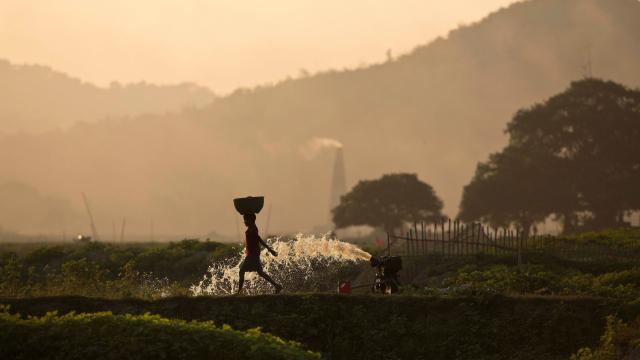A new analysis is reigniting a concern agricultural scientists have been voicing for years: That rising carbon dioxide could exacerbate malnutrition by reducing the nutrient content of staple crops.
The study, published Monday in Nature Climate Change, projects that if atmospheric carbon dioxide levels rise to 550 parts per million (ppm) — a level conceivable by later this century if we don’t aggressively reduce emissions — it could result in an additional 175 million zinc deficiencies and 122 million protein deficiencies worldwide.
The study also concluded that by mid-century, some 1.4 billion women and children under five will live in regions facing a high risk of iron deficiency.
There are a lot of assumptions baked into these model-borne estimates, but the findings fall in line with other recent analyses. For instance, a study published last month projected that rising carbon dioxide could result in an additional 126 million life years lost by 2050 due to falling iron and zinc concentrations in crops. And a widely-publicised paper from May projected that the protein, iron, zinc and B vitamin content of various cultivars of rice would fall as carbon dioxide rises.
“The growing body of literature on the impacts of rising carbon dioxide concentrations on the nutritional quality of our food indicates the health consequences could be significant, particularly for poorer populations in Africa and Asia,” Kristie Ebi, director of the Center for Health and the Global Environment at the University of Washington and a co-author on the aforementioned papers from May and July, told us.
The basic premise here is that crops take up carbon dioxide from the atmosphere for photosynthesis, and as carbon dioxide levels rise, some crop plants incorporate more of it into their tissue relative to nutrients they acquire from the soil. This, in essence, dilutes the nutrients.
Experimental studies have demonstrated this effect for a wide variety of nutrients and crops, including zinc and iron in major staples such as wheat and rice. Previous modelling studies, meanwhile, have projected the impacts of this into the future under a range of different assumptions.
The new study expands on prior research by looking at 151 countries and 225 foods under a single set of assumptions and using more detailed food supply datasets for individual countries. The Harvard-based authors also pulled data on human nutritional requirements, and from their own previous analyses of the carbon dioxide-responsiveness of various crops, to consider the impacts of a 550 ppm world on dietary intake of iron, zinc and protein.
The hundreds of millions of additional nutrient deficiencies the researchers project are most concentrated in low-income regions featuring more plant-rich diets, including India, Southeast Asia, Sub-Saharan and North Africa, and the Middle East. The findings reinforce the overall picture of a disproportionate climate change burden falling on the world’s poor.
But they also rely on some big assumptions, chiefly that diets in these countries won’t change over the coming century. Changes in the types of crops grown — some staples, such as maize and millet, appear less sensitive to carbon dioxide — or the particular cultivars could counteract a decline in nutritional quality.
Many agricultural changes might be necessitated around the world this century as temperatures climb, rainfall patterns change, fire seasons lengthen, and droughts and heat waves intensify. How carbon dioxide’s effects on nutrition slot into this bigger, more complex picture is something researchers are still working out.
As a final caveat, Ebi pointed out that the authors’ model makes use of some unpublished datasets about the effects of carbon dioxide on minerals, “making it difficult to check the validity of the raw data”. We reached out to the study authors for comment but had not heard back at time of writing.
Overall, the authors’ message that all else being equal, rising carbon dioxide levels could exacerbate nutritional deficiencies is part of a growing body of work. The suggestion that vulnerable regions should monitor their crops and plan for such an effect, whether through breeding new cultivars, different growing techniques or national supplementation programs, seems well-advised.
“Another clear and direct intervention globally would be to redouble efforts to reduce global CO2 emissions,” the authors write.
